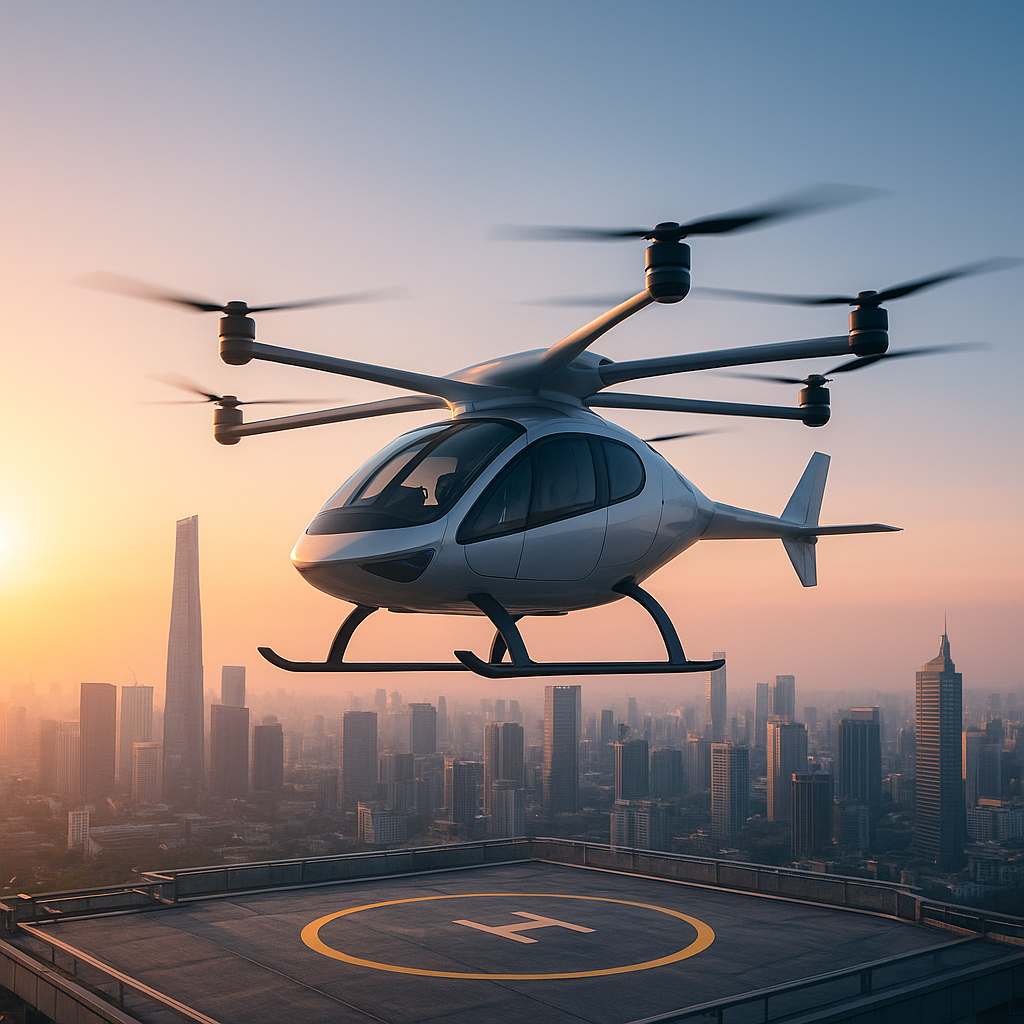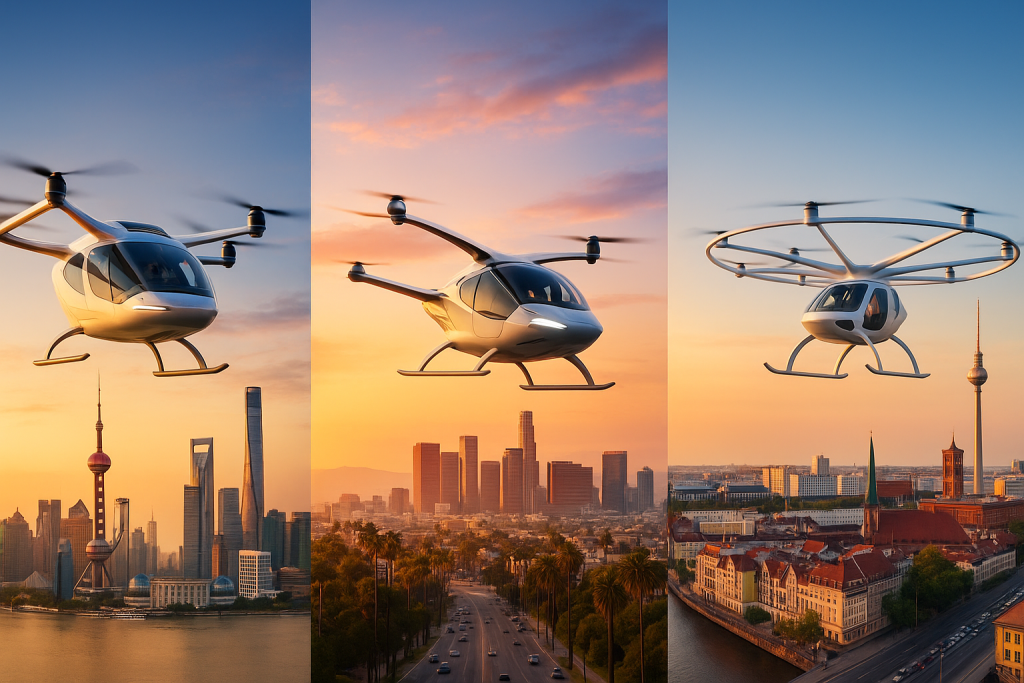China’s Civil Aviation Administration issued air operator certificates to EHang Holdings and its joint venture Heyi Aviation, allowing their passenger drones to carry paying customers. The certified model, the EH216-S, is an autonomous two-seat electric Vertical Take-Off and Landing aircraft, or eVTOL. These futuristic vehicles are not cars in the conventional sense but electrically powered aircraft designed for short flights across cities, capable of bypassing congestion and drastically reducing travel time.
The development has been hailed as a watershed moment. For decades, flying cars have lingered in the public imagination as a Jetsons-style fantasy. Yet in 2025, China made them real.
A new chapter in aviation
The EH216-S looks less like a car with wings and more like an oversized drone. With 16 rotors mounted on eight arms, it operates entirely autonomously, without the need for a pilot. Passengers enter the cabin, fasten seatbelts, and the vehicle navigates itself. The flight is coordinated from a ground control centre, using a network of sensors, GPS, and real-time communications with air traffic authorities.
Its specifications are modest but striking. With a maximum range of around 35 kilometres and a cruising speed of 130 kilometres per hour, the EH216-S is built for short-range urban commuting and tourism. The airframe is crafted from carbon fibre reinforced polymer (CFRP), giving it both stiffness and lightness. Propeller blades use a blend of carbon composites and aramid fibres, while critical joints rely on titanium alloys for fatigue resistance. The canopy is made from polycarbonate, lighter than glass but impact resistant.
The choice of materials is not incidental. Engineers balance strength-to-weight ratios, thermal stability, and fire resistance when designing passenger drones. CFRP dominates due to its extraordinary stiffness-to-weight efficiency. Aluminium alloys are deployed in landing gear and motor housings, while battery casings incorporate ceramic barriers and fire-retardant resins to mitigate the risk of thermal runaway. Each decision reflects an aerospace-level compromise between safety, cost, and performance.
This is not just a technology story. It is a competition of nations, of industries, and of visions for the future of cities.
-Aviation Analyst
A new chapter in aviation
The EH216-S looks less like a car with wings and more like an oversized drone. With 16 rotors mounted on eight arms, it operates entirely autonomously, without the need for a pilot. Passengers enter the cabin, fasten seatbelts, and the vehicle navigates itself. The flight is coordinated from a ground control centre, using a network of sensors, GPS, and real-time communications with air traffic authorities.
Its specifications are modest but striking. With a maximum range of around 35 kilometres and a cruising speed of 130 kilometres per hour, the EH216-S is built for short-range urban commuting and tourism. The airframe is crafted from carbon fibre reinforced polymer (CFRP), giving it both stiffness and lightness. Propeller blades use a blend of carbon composites and aramid fibres, while critical joints rely on titanium alloys for fatigue resistance. The canopy is made from polycarbonate, lighter than glass but impact resistant.
The choice of materials is not incidental. Engineers balance strength-to-weight ratios, thermal stability, and fire resistance when designing passenger drones. CFRP dominates due to its extraordinary stiffness-to-weight efficiency. Aluminium alloys are deployed in landing gear and motor housings, while battery casings incorporate ceramic barriers and fire-retardant resins to mitigate the risk of thermal runaway. Each decision reflects an aerospace-level compromise between safety, cost, and performance.
The science of flying cars
Behind the smooth bodywork lies a blend of aerospace engineering and electric mobility. At its heart, the EH216-S is powered by lithium-ion batteries similar to those in electric vehicles, but optimised for aviation. These cells provide high discharge rates and are supported by liquid cooling loops and thermal foams to prevent overheating.
The propulsion system consists of multiple brushless DC electric motors that drive the rotors. Unlike helicopters, which rely on a single large rotor, distributed propulsion spreads the lift across many smaller rotors. This improves redundancy. If one motor fails, others continue operating, allowing the aircraft to remain airborne. It also helps reduce noise, a critical factor for acceptance in urban environments.
Flight stability is maintained through sophisticated control algorithms. Triple-redundant flight computers process signals from accelerometers, gyroscopes, LiDAR, and GPS. Autonomous navigation allows the aircraft to plan routes, avoid obstacles, and land safely even if communications fail. Engineers call this “fly-by-wire autonomy”, where the software effectively replaces the pilot.
Noise and comfort in the skies
For urban air mobility to succeed, the public must embrace it. One of the biggest hurdles is noise. A helicopter generates an unmistakable low-frequency thrum, often described as unbearable in city centres. eVTOLs attempt to solve this by using multiple rotors tuned to spread noise across frequencies less detectable to the human ear.
Companies like Joby Aviation in the United States claim their aircraft are 100 times quieter than helicopters during take-off and landing. EHang makes similar promises, noting that distributed propulsion not only reduces noise but vibration, improving passenger comfort. Cabins are fitted with energy-absorbing foams and honeycomb sandwich composites to dampen resonance.
Cabin experience is also engineered to reassure passengers. Large polycarbonate windows provide visibility, while interior displays show the route, speed, and destination. Designers argue this transparency helps overcome the anxiety of flying in an autonomous craft without a pilot at the controls.
A global race for dominance
China’s decision to approve pilotless passenger drones places it ahead of many rivals. In the United States, Joby Aviation has made headlines by completing the first eVTOL flight between two public airports, flying from Marina to Monterey in California. Yet its aircraft remains piloted, as American regulators prioritise human oversight in early deployments.
Europe has seen innovation but also setbacks. Volocopter, based in Germany, pioneered the concept of VoloPorts, futuristic hubs for eVTOL operations. However, delays in certification and funding have slowed progress. Lilium, another German company, entered insolvency in 2024 after struggling to bring its seven-seat Lilium Jet to market.
China, by contrast, has surged ahead with approvals. It now accounts for nearly 50 percent of global eVTOL models, supported by demonstration zones across the country. The government’s top-down regulatory approach has enabled EHang and others to scale faster, whereas Western companies face longer certification cycles. As Time reported, this is not just about aircraft but about industrial leadership.
Materials that shape the future
The material science behind flying cars deserves its own attention. Unlike automobiles, where weight is less critical, every kilogram saved in an aircraft translates into extra range or payload. Engineers design using what is often called a material selection map, choosing CFRP for fuselage structures, titanium for high-stress joints, and polycarbonate for canopies.
This hybrid approach mirrors techniques used in aerospace but must also be scaled for production more like the automotive industry. Emerging trends include graphene-enhanced composites for conductivity and strength, and thermoplastic composites that can be recycled and manufactured faster than traditional thermosets. Some research groups are experimenting with hybrid metal-composite joints, combining the toughness of metals with the lightness of composites.
Challenges nobody can ignore
Despite the headlines, significant barriers remain. Noise and passenger trust may prove as daunting as engineering itself. Infrastructure is another missing piece. eVTOLs require vertiports, which serve as hubs for boarding and charging. Some designs use swappable battery packs, while others rely on ultrafast charging. Both will strain urban electrical grids if scaled widely.
Safety is paramount. The redundancy built into eVTOLs reflects this priority. Multiple rotors, independent battery systems, and triple-redundant computers ensure no single point of failure. Yet the public perception of risk remains high. Some prototypes include ballistic parachutes for last-resort emergencies. Cybersecurity is another overlooked dimension, with fears of GPS spoofing or remote hacking.
In short, the technology may be close, but social, regulatory, and infrastructural challenges could delay mainstream adoption.
The future of cities and the sky
The introduction of licensed flying cars in China is more than a national milestone. It marks the beginning of a global reimagining of urban mobility. Supporters argue that eVTOLs could reduce road congestion, cut emissions if powered by renewable electricity, and open new markets for tourism and logistics. Critics warn of inequality, with flying cars becoming luxury transport for the wealthy rather than a mass solution.
As cities grapple with climate goals and population growth, the choice is no longer whether flying cars are possible but how they will be integrated responsibly. Will they coexist with trains and buses, or compete against them? Will they serve the many, or the few?
The world has entered a new race, not only for engineering supremacy but for the right to shape the urban skies. As China flies ahead, the United States, Europe, and other nations must decide how to balance innovation with regulation. The future of transport is arriving vertically. The only question is: are we ready to look up?








